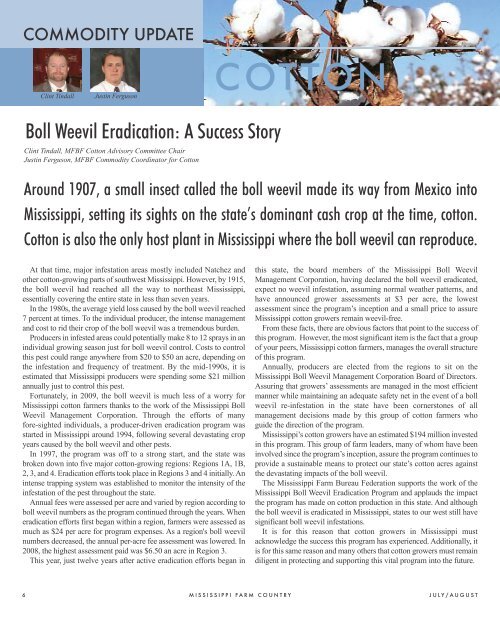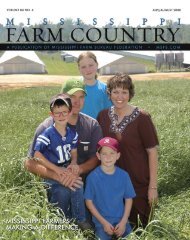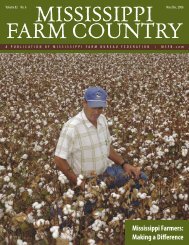July/August-09:Layout 1 - Mississippi Farm Bureau Federation
July/August-09:Layout 1 - Mississippi Farm Bureau Federation
July/August-09:Layout 1 - Mississippi Farm Bureau Federation
Create successful ePaper yourself
Turn your PDF publications into a flip-book with our unique Google optimized e-Paper software.
COMMODITY UPDATE<br />
Clint Tindall<br />
Justin Ferguson<br />
Boll Weevil Eradication: A Success Story<br />
Clint Tindall, MFBF Cotton Advisory Committee Chair<br />
Justin Ferguson, MFBF Commodity Coordinator for Cotton<br />
At that time, major infestation areas mostly included Natchez and<br />
other cotton-growing parts of southwest <strong>Mississippi</strong>. However, by 1915,<br />
the boll weevil had reached all the way to northeast <strong>Mississippi</strong>,<br />
essentially covering the entire state in less than seven years.<br />
In the 1980s, the average yield loss caused by the boll weevil reached<br />
7 percent at times. To the individual producer, the intense management<br />
and cost to rid their crop of the boll weevil was a tremendous burden.<br />
Producers in infested areas could potentially make 8 to 12 sprays in an<br />
individual growing season just for boll weevil control. Costs to control<br />
this pest could range anywhere from $20 to $50 an acre, depending on<br />
the infestation and frequency of treatment. By the mid-1990s, it is<br />
estimated that <strong>Mississippi</strong> producers were spending some $21 million<br />
annually just to control this pest.<br />
Fortunately, in 20<strong>09</strong>, the boll weevil is much less of a worry for<br />
<strong>Mississippi</strong> cotton farmers thanks to the work of the <strong>Mississippi</strong> Boll<br />
Weevil Management Corporation. Through the efforts of many<br />
fore-sighted individuals, a producer-driven eradication program was<br />
started in <strong>Mississippi</strong> around 1994, following several devastating crop<br />
years caused by the boll weevil and other pests.<br />
In 1997, the program was off to a strong start, and the state was<br />
broken down into five major cotton-growing regions: Regions 1A, 1B,<br />
2, 3, and 4. Eradication efforts took place in Regions 3 and 4 initially. An<br />
intense trapping system was established to monitor the intensity of the<br />
infestation of the pest throughout the state.<br />
Annual fees were assessed per acre and varied by region according to<br />
boll weevil numbers as the program continued through the years. When<br />
eradication efforts first began within a region, farmers were assessed as<br />
much as $24 per acre for program expenses. As a region's boll weevil<br />
numbers decreased, the annual per-acre fee assessment was lowered. In<br />
2008, the highest assessment paid was $6.50 an acre in Region 3.<br />
This year, just twelve years after active eradication efforts began in<br />
COTTON<br />
Around 1907, a small insect called the boll weevil made its way from Mexico into<br />
<strong>Mississippi</strong>, setting its sights on the state’s dominant cash crop at the time, cotton.<br />
Cotton is also the only host plant in <strong>Mississippi</strong> where the boll weevil can reproduce.<br />
this state, the board members of the <strong>Mississippi</strong> Boll Weevil<br />
Management Corporation, having declared the boll weevil eradicated,<br />
expect no weevil infestation, assuming normal weather patterns, and<br />
have announced grower assessments at $3 per acre, the lowest<br />
assessment since the program’s inception and a small price to assure<br />
<strong>Mississippi</strong> cotton growers remain weevil-free.<br />
From these facts, there are obvious factors that point to the success of<br />
this program. However, the most significant item is the fact that a group<br />
of your peers, <strong>Mississippi</strong> cotton farmers, manages the overall structure<br />
of this program.<br />
Annually, producers are elected from the regions to sit on the<br />
<strong>Mississippi</strong> Boll Weevil Management Corporation Board of Directors.<br />
Assuring that growers’ assessments are managed in the most efficient<br />
manner while maintaining an adequate safety net in the event of a boll<br />
weevil re-infestation in the state have been cornerstones of all<br />
management decisions made by this group of cotton farmers who<br />
guide the direction of the program.<br />
<strong>Mississippi</strong>’s cotton growers have an estimated $194 million invested<br />
in this program. This group of farm leaders, many of whom have been<br />
involved since the program’s inception, assure the program continues to<br />
provide a sustainable means to protect our state’s cotton acres against<br />
the devastating impacts of the boll weevil.<br />
The <strong>Mississippi</strong> <strong>Farm</strong> <strong>Bureau</strong> <strong>Federation</strong> supports the work of the<br />
<strong>Mississippi</strong> Boll Weevil Eradication Program and applauds the impact<br />
the program has made on cotton production in this state. And although<br />
the boll weevil is eradicated in <strong>Mississippi</strong>, states to our west still have<br />
significant boll weevil infestations.<br />
It is for this reason that cotton growers in <strong>Mississippi</strong> must<br />
acknowledge the success this program has experienced. Additionally, it<br />
is for this same reason and many others that cotton growers must remain<br />
diligent in protecting and supporting this vital program into the future.<br />
6 M I S S I S S I P P I F A R M C O U N T R Y J U L Y / A U G U S T




